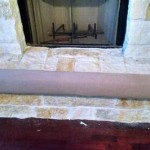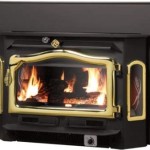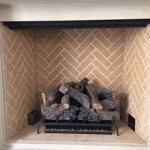Wood Burning Fireplace Insert: Enhancing Efficiency and Aesthetics
A wood burning fireplace insert represents a significant upgrade to a traditional open-hearth fireplace. It is essentially a self-contained firebox that is inserted into an existing fireplace opening, offering increased heating efficiency, improved safety, and reduced emissions. The functionality and design of wood burning inserts aim to address the inherent drawbacks of conventional fireplaces, which are notoriously inefficient and contributors to indoor air pollution.
Traditional fireplaces draw air from the room, which is then heated and largely expelled up the chimney. This creates a negative pressure in the room, pulling in cold air from around doors and windows to compensate. The result is a cycle of heated air loss and cold air infiltration, negating much of the intended warmth. Fireplace inserts, on the other hand, are designed to mitigate these issues. They are typically constructed of cast iron or steel and feature a sealed firebox, which allows for controlled combustion and significantly reduces the amount of heat lost up the chimney.
Beyond the practical advantages, wood burning fireplace inserts also offer aesthetic enhancements. Available in a variety of styles, finishes, and sizes, they can be selected to complement the existing décor of a home. From classic designs with intricate detailing to contemporary models with clean lines, there is an insert to suit virtually any taste. Many inserts also feature large glass doors, providing a clear view of the fire and creating a cozy ambiance.
Increased Heating Efficiency
The primary benefit of a wood burning fireplace insert is its superior heating efficiency compared to an open fireplace. Open fireplaces typically have an efficiency rating of only 5% to 10%, meaning that a vast majority of the heat generated by the fire escapes up the chimney. This is due to the uncontrolled combustion process and the large volume of air that is drawn through the fireplace.
Wood burning inserts, however, can achieve efficiency ratings of 60% to 80% or even higher, depending on the model and design. This improvement is achieved through several factors. First, the sealed firebox allows for controlled combustion, ensuring that the wood burns more completely and efficiently. Secondly, many inserts incorporate features such as baffles and secondary combustion systems, which help to extract more heat from the exhaust gases before they are released up the chimney.
Baffles are internal plates or chambers that redirect the flow of hot gases, forcing them to travel a longer path through the firebox. This allows more time for heat to be transferred to the surrounding metal, which then radiates into the room. Secondary combustion systems introduce preheated air into the firebox to burn off any remaining unburned gases and particulate matter, further increasing efficiency and reducing emissions.
In addition, the metal construction of the insert serves as an effective heat sink, absorbing heat from the fire and radiating it into the room. This radiant heat is much more efficient at warming a space than the convective heat produced by an open fireplace. The increased efficiency of wood burning inserts translates to significant savings on heating costs, especially for homeowners who rely heavily on wood as their primary heat source.
Some models incorporate a forced-air system with a fan that circulates heated air into the room, further enhancing heat distribution. This helps to prevent the heat from concentrating solely around the fireplace and ensures that the entire space is warmed more evenly. The use of a thermostat can also automate the fan, maintaining a consistent temperature and maximizing efficiency.
Improved Safety Features
Traditional open fireplaces pose several safety hazards, including the risk of sparks and embers escaping the firebox, creating a fire hazard. The uncontrolled combustion process can also lead to the buildup of creosote in the chimney, which is a highly flammable substance that can cause chimney fires. In addition, the high temperatures of the firebox can pose a burn risk to people and pets who come into close contact with the fireplace.
Wood burning fireplace inserts are designed with safety in mind, incorporating features that mitigate these risks. The sealed firebox prevents sparks and embers from escaping, reducing the risk of fires spreading to nearby carpets or furniture. The controlled combustion process also minimizes the formation of creosote, reducing the likelihood of chimney fires.
Many inserts feature a glass door that covers the firebox opening, providing a barrier between the fire and the surrounding environment. This prevents accidental contact with the flames and reduces the risk of burns. The glass doors are typically made of high-temperature ceramic glass, which can withstand the extreme heat of the firebox without cracking or shattering.
Moreover, the design of a wood burning insert often includes a surround or faceplate that covers the gap between the insert and the existing fireplace opening. This helps to prevent drafts and further reduces the risk of sparks or embers escaping. It also enhances the aesthetic appeal of the installation, creating a more finished and professional look.
The proper installation of a wood burning fireplace insert is crucial to ensure its safe and efficient operation. It is recommended to have the insert installed by a qualified professional who is familiar with local building codes and safety regulations. The installation should include a thorough inspection of the chimney to ensure that it is clean, structurally sound, and properly sized for the insert. A stainless steel chimney liner is often required to protect the existing chimney from the corrosive byproducts of combustion.
Reduced Emissions and Environmental Impact
Open fireplaces are significant contributors to air pollution, releasing harmful pollutants such as particulate matter, carbon monoxide, and volatile organic compounds (VOCs) into the atmosphere. These pollutants can have negative impacts on human health and the environment.
Wood burning fireplace inserts are designed to burn wood more cleanly and efficiently, resulting in lower emissions compared to open fireplaces. Inserts certified by the Environmental Protection Agency (EPA) meet strict emission standards, ensuring that they release minimal pollutants into the air. The EPA certification process involves rigorous testing to verify that the insert meets specific emission limits for particulate matter.
The controlled combustion process in wood burning inserts helps to reduce the amount of unburned gases and particulate matter that are released into the atmosphere. Secondary combustion systems, as mentioned earlier, further improve combustion efficiency and reduce emissions by burning off any remaining pollutants. The use of a catalytic combustor, in some models, can further reduce emissions by facilitating the oxidation of pollutants at lower temperatures.
By reducing emissions, wood burning fireplace inserts contribute to cleaner air and a healthier environment. They can be a more sustainable heating option compared to open fireplaces, especially when used with sustainably harvested wood. The use of seasoned wood, which has been properly dried, also helps to reduce emissions and improve combustion efficiency. Wet or green wood produces more smoke and creosote, leading to higher emissions and increased risk of chimney fires.
The overall environmental impact of wood burning fireplace inserts depends on several factors, including the type of wood used, the efficiency of the insert, and the frequency of use. However, when used responsibly and with properly seasoned wood, they can be a relatively clean and efficient heating option. Regular maintenance, including chimney cleaning and inspection, is essential to ensure that the insert continues to operate efficiently and safely.
Choosing the right size of wood burning insert is also crucial for optimal performance and reduced emissions. An oversized insert will not burn efficiently, leading to increased creosote buildup and higher emissions. A properly sized insert will burn cleanly and efficiently, providing a comfortable and sustainable heating solution.
In summary, a wood burning fireplace insert provides a significant improvement over traditional open fireplaces in terms of heating efficiency, safety, and environmental impact. Its controlled combustion process, sealed firebox, and advanced features result in increased heat output, reduced risk of fire, and lower emissions. When properly installed and maintained, a wood burning insert can be a valuable addition to any home, providing a cozy and sustainable heating option.

Napoleon Epi3 Wood Fireplace Insert Inserts By Rockford Chimney

Wood Burning Fireplace Inserts Insert Installation

Wood Inserts We Love Fire

T25i Timberwolf Wood Fireplace Insert Hearth Stove Patio

Why A Wood Burning Fireplace Insert Bethesda Md Service

Ventis Hei240 Wood Burning Insert Rockford Chimney

Lopi Premium Wood Fireplace Inserts Custom Hearth Fireplaces And Stoves
.aspx?strip=all)
Cost Of Operating A Wood Insert Cord Calculator Regency

What S Best A Fireplace Stove Or Insert We Love Fire

Wood Burning Fireplace Inserts Sierra Hearth And Home
Related Posts








